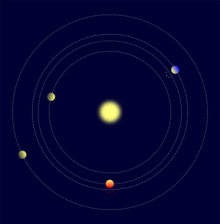
Kepler-4b, initially known as KOI 7.01, is an extrasolar planet first detected as a transit by the Kepler spacecraft. Its radius and mass are similar to that of Neptune; however, due to its proximity to its host star, it is substantially hotter than any planet in the Solar System. The planet's discovery was announced on January 4, 2010, in Washington, D.C., along with four other planets that were initially detected by the Kepler spacecraft and subsequently confirmed by telescopes at the W.M. Keck Observatory.
The Kepler Input Catalog is a publicly searchable database of roughly 13.2 million targets used for the Kepler Spectral Classification Program (SCP) and Kepler.
A Kepler object of interest (KOI) is a star observed by the Kepler space telescope that is suspected of hosting one or more transiting planets. KOIs come from a master list of 150,000 stars, which itself is generated from the Kepler Input Catalog (KIC). A KOI shows a periodic dimming, indicative of an unseen planet passing between the star and Earth, eclipsing part of the star. However, such an observed dimming is not a guarantee of a transiting planet, because other astronomical objects—such as an eclipsing binary in the background—can mimic a transit signal. For this reason, the majority of KOIs are as yet not confirmed transiting planet systems.

Kepler-70, also known as KIC 5807616 and formerly as KOI-55, is a star in the constellation Cygnus with an apparent visual magnitude of 14.87, and is 4200 light-years away. This is too faint to be seen with the naked eye; viewing it requires a telescope with an aperture of 40 cm (20 in) or more. A subdwarf B star, Kepler-70 passed through the red giant stage some 18.4 million years ago. In its present-day state, it is fusing helium in its core. Once it runs out of helium it will contract to form a white dwarf. It has a relatively small radius of about 0.2 times the Sun's radius; white dwarfs are generally much smaller. The star may be host to a planetary system with two planets, although later research indicates that this is not in fact the case. If they are confirmed to exist, then the innermost planet has the highest temperature of any known planet.

Kepler-42, formerly known as KOI-961, is a red dwarf located in the constellation Cygnus and approximately 131 light years from the Sun. It has three known extrasolar planets, all of which are smaller than Earth in radius, and likely also in mass.
Kepler-1520 is a K-type main-sequence star located in the constellation Cygnus. The star is particularly important, as measurements taken by the Kepler spacecraft indicate that the variations in the star's light curve cover a range from about 0.2% to 1.3% of the star's light being blocked. This indicates that there may be a rapidly disintegrating planet, a prediction not yet conclusively confirmed, in orbit around the star, losing mass at a rate of 1 Earth mass every billion years. The planet itself is about 0.1 Earth masses, or just twice the mass of Mercury, and is expected to disintegrate in about 100-200 million years. The planet orbits its star in just 15.7 hours, at a distance only two stellar diameters away from the star's surface, and has an estimated effective temperature of about 2255 K. The orbital period of the planet is one of the shortest ever detected in the history of the extrasolar planet search. In 2016, the planet was confirmed as part of a data release by the Kepler spacecraft.
Kepler-32 is an M-type main sequence star located about 1070 light years from Earth, in the constellation of Cygnus. Discovered in January 2012 by the Kepler spacecraft, it shows a 0.58 ± 0.05 solar mass (M☉), a 0.53 ± 0.04 solar radius (R☉), and temperature of 3900.0 K, making it half the mass and radius of the Sun, two-thirds its temperature and 5% its luminosity.
Kepler-89 is a star with four confirmed planets. Kepler-89 is a possible wide binary star.

Kepler-69 is a G-type main-sequence star similar to the Sun in the constellation Cygnus, located about 2,430 ly (750 pc) from Earth. On April 18, 2013 it was announced that the star has two planets. Although initial estimates indicated that the terrestrial planet Kepler-69c might be within the star's habitable zone, further analysis showed that the planet very likely is interior to the habitable zone and is far more analogous to Venus than to Earth and thus completely inhospitable.

Kepler-56 is a red giant in constellation Cygnus roughly 3,060 light-years (940 pc) away with slightly more mass than the Sun.

Kepler-25 is a star in the northern constellation of Lyra. It is slightly larger and more massive than the sun with a luminosity 21⁄2 times that of the sun. With an apparent visual magnitude of 10.6, this star is too faint to be seen with the naked eye.

Kepler-90g is a super-puff exoplanet orbiting the early G-type main sequence star Kepler-90, one of eight planets around this star discovered using NASA's Kepler space telescope. It is located about 2,840 light-years (870 pc) from Earth, in the constellation Draco. The exoplanet was found by using the transit method, in which the dimming effect that a planet causes as it crosses in front of its star is measured. It orbits its parent star about every 210.5 days at a distance of 0.71 astronomical units.

Kepler-138, also known as KOI-314, is a red dwarf located in the constellation Lyra, 219 light years from Earth. It is located within the field of vision of the Kepler spacecraft, the satellite that NASA's Kepler Mission used to detect planets transiting their stars.
Kepler-30 is a star in the northern constellation of Lyra. It is located at the celestial coordinates: Right Ascension 19h 01m 08.0747s Declination +38° 56′ 50.219″. With an apparent visual magnitude of 15.5, this star is too faint to be seen with the naked eye. Kepler-30 is exhibiting a strong starspot activity.
Kepler-29 is a Sun-like star in the northern constellation of Cygnus. It is located at the celestial coordinates: Right Ascension 19h 53m 23.6020s, Declination +47° 29′ 28.436″. With an apparent visual magnitude of 15.456, this star is too faint to be seen with the naked eye. It is a solar analog, having a close mass, radius, and temperature as the Sun. Currently the age of the star has not been determined due to its 2780 light-year distance. As of 2016 no Jovian exoplanets of 0.9–1.4 MJ have been found at a distance of 5 AU.
Kepler-444 is a triple star system, estimated to be 11.2 billion years old, approximately 119 light-years (36 pc) away from Earth in the constellation Lyra. On 27 January 2015, the Kepler spacecraft is reported to have confirmed the detection of five sub-Earth-sized rocky exoplanets orbiting the main star. The star is a K-type main sequence star. All of the planets are far too close to their star to harbour life forms.
Kepler-1229 is a red dwarf star located about 870 light-years (270 pc) away from the Earth in the constellation of Cygnus. It is known to host a super-Earth exoplanet within its habitable zone, Kepler-1229b, which was discovered in 2016.
Kepler-419 is an F-type main-sequence star located about 3,400 light years from Earth in the constellation Cygnus. It is located within the field of vision of the Kepler spacecraft, the satellite that NASA's Kepler Mission used to detect planets that may be transiting their stars. In 2012, a potential planetary companion in a very eccentric orbit was detected around this star, but its planetary nature was not confirmed until 12 June 2014, when it was named Kepler-419b. A second planet was announced orbiting further out from the star in the same paper, named Kepler-419c.
Kepler-13 or KOI-13 is a stellar triple star system consisting of Kepler-13A, around which an orbiting hot Jupiter exoplanet was discovered with the Kepler spacecraft in 2011, and Kepler-13B a common proper motion companion star which has an additional star orbiting it.
Kepler-635 is an F7V star with an extrasolar planetary system discovered by the Kepler space telescope. The star was first thought to be variable, but later determined to be static.









